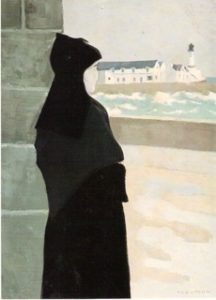Following on from my question “Why do we paint?” in December’s Update, I have carried out further research via the internet [technology can have its rewarding side!] into the source of the tiny print, which was hanging on a cafe wall in Ireland, and so inspired me 22 years ago. It has thrown up some very interesting information, and posed yet more questions.
The tiny etching [approx. 6”x 4”] was signed ‘R L Dufour ‘, which I noted in my sketchbook as I made my initial drawing. It is clearly a copy of this original Dufour painting which I believe is an oil on canvas, 3’x 2’.
I saw in the print a woman looking out onto a very dark, stormy sky and windswept sea ‘. My initial drawing confirms this is clearly not the case in the above original painting.
Looking for answers, Google found the below video for me. It’s a perfect example of how an artist can be inspired to produce stunning individual images of his / her immediate environment.
The trick, firstly, is to have the eye to see, and then to have the technique to convey your ideas to others. Dufour does both in the simplest of ways.
(Watch Dufour video on YouTube.)
At first, his monochromatic images and shapes can appear cold and unfinished.
Then, you look at the people in the video, and their environment [of which he is a part] and you quickly come to realise where his inspiration to paint that way comes from. His use of, or lack of colour, painted in strong shapes and bold use of negative spaces perfectly captures the stark coastal environment, which surrounds him and his subjects.
I can find no mention of R L Dufour https://www.mbbsmedicalcollege.com/kamagra.html ever producing etchings of his work.
So how did a tiny print produced in Bretagne, and signed by him, arrive on a café wall in a remote corner of Ireland?
Why did that small printed image have such an immediate effect on me at the time and lead me to an artist who I can so readily associate with, although I cannot understand a word of the French video?
Is that not the power of the visual arts, and why painting is such a fascinating subject when you take the time to ’ look beyond ‘ the actual imagery? Art is visual communication, but can go way beyond the merely visual.
Several years ago, I was contacted by an elderly lady who owned one of my very early paintings. She explained she was seriously ill, and as her family were not interested in art, asked if I would like the painting back? I politely declined for the following reason-:
One aspect of being a painter is that when you have completed a piece of work, and it’s sold, it takes on a life of its own, and hopefully will be around for many years to come for others to enjoy. A bit like your family growing up.
I have received several such emails over the past few years, even one from Australia! That again is just one of the many reasons why I paint.
For the past 22 years I have lived with the memory of that chance encounter with one small etching. Via my sketchbook, my ‘Hopeless Dawn’ painting and research, I still find it having an effect on my life. Is that not what art should be all about?
Michael Smith, Dersingham
